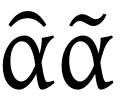(MAC OS 12.6 on 2021 Macbook Pro 2021 M1) According to the the keyboard diagram the circumflex appears on typing Right Option + one key to the left of the back space key (ie the + and = key), but I keep getting a tilde over my η’s etc… The inverse or concave circumflex ( ˘ ) works fine, one key to further the left… Thoughts?
Testing… Question not showing up on main topic list…
Could you tell us which keyboard you are using with Keyman? It’s hard to infer which keyboard you are using from what’s written here, and that information would help us to investigate this more directly and to attempt to reproduce what you’re seeing.
This is a unique situation in Greek, and is not a keyboard bug. It depends on which font you’re using. In Greek font styles the ‘circumflex’ can have two different shapes. The rounded style (Porsonic style) is more common in NT publications and other Koine greek texts and textbooks. A second style looks just like a Latin tilde and is more common for other ancient Greek texts. Here are examples of both from our Gentium Plus font:

Most of our users prefer the tilde-style, as that’s more universally common, and similar to other popular fonts such as Cardo and SBL Greek.
The Porsonic style is available in Gentium Plus through an OpenType feature (Porsonic circumflex - cv78 - near the end of this page). A modified font with that feature turned on by default can be created using TypeTuner Web. Choose Gentium Plus and change the setting of the Greek circumflex feature.
We have an older font—Galatia SIL—that uses the Porsonic style by default, but it’s a much more limited font.
If you are talking about this keyboard: Greek Classical keyboard
It does come with Galatia SIL as the default font. You can simply change your font to one that uses the style of circumflex you prefer.
Thanks everyone! I wish I could get over wanting to have the Porsonic circumflex – especially because I’m not experienced with messing with fonts – but the textbook I’ve been assigned (Lusching - An Introduction to Ancient Greek: A Literary Approach) uses the Porsonic and the tilde will drive me crazy.
When you say the Galatia SIL is much more limited, how do you mean? I’ve been quasi teaching myself Greek for some time, but this is my first official course and so I’m definitely a beginner and may not need a super extensive character set…
In any case, I’ve downloaded the Galatia SIL, but I can’t figure out how to get it working with the Keyman App. I’m on MAC OS 12.6 on 2021 Macbook Pro 2021 M1 and Font Book doesn’t come up when I double click on the unzipped file, and I can’t seem to make the Library Folder appear pressing shift option in Finder — in fact the only Library folder I can make show up has almost nothing in it…
Anyway, any suggestions much appreciated. Best — JM
I’m not sure why Font Book isn’t opening. Are you double-clicking on the GalSILR.ttf file? You can try right-clicking on that file and choose Open with… Font Book. That should show you the font and give you the option to install it.
Galatia has only regular and bold. Gentium Plus has those plus italics. Galatia also does not support as wide a range of ancient Greek symbols as Gentium Plus. However if you’re just learning Greek Galatia should meet your needs.
I actually got the Gentium Plus modifified to the Porsonic using Type Tuner – it wasn’t as complicated to do as I’d thought. Thanks again. Best — JM
Great! Glad that worked for you.
This conversation has been resolved.